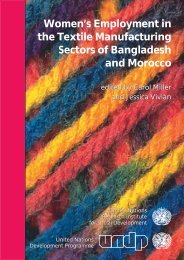RESEARCH REPORT 4 Paid Care Workers in Tanzania:
RESEARCH REPORT 4 Paid Care Workers in Tanzania:
RESEARCH REPORT 4 Paid Care Workers in Tanzania:
Create successful ePaper yourself
Turn your PDF publications into a flip-book with our unique Google optimized e-Paper software.
External Support for Chronically ill Adults, <strong>Tanzania</strong> 2003-04<br />
Background Medical Emotional Material or All three Number of<br />
characteristic Support Support practical types of chronically<br />
support support ill persons<br />
Age<br />
18-29 15.6 % 14.1% 8.5% 3.5% 102<br />
30-39 16.7% 18.7% 11.2% 2.2% 101<br />
40-49 17.3% 9.1% 15.4% 4.7% 81<br />
50-59 15.7% 11.9% 12.0 5. 4% 70<br />
Sex<br />
Male 21.4% 20.3% 12.% 5.8% 153<br />
Female 12.4% 8.9% 10.8% 2.2% 201<br />
Residence<br />
Urban 29.7% 23.9% 16.7% 3.9% 82<br />
Rural 12.3% 10.8% 10.0% 3.7% 273<br />
Wealth<br />
Qu<strong>in</strong>tile<br />
lowest 14.3% 17.7% 12.2% 5.4% 91<br />
Second 14.8% 10.8% 6.6% 3.3% 69<br />
Middle 12.0% 2.8% 5.7% 2.8% 74<br />
Fourth 12.8% 12.6% 14.3% 1.6% 58<br />
Highest 29.2% 25.5% 20.5% 5.1% 63<br />
Total 16.3% 13.8 11.6 3.8 355<br />
Source: THIS: 2003/04. MoH/NBS: 2004 pg. 17).<br />
The above table suggests that although the majority of <strong>Tanzania</strong>ns are will<strong>in</strong>g to support a<br />
PLWHA <strong>in</strong> their own households 1 , there is very little external support trickl<strong>in</strong>g down to these<br />
households with the PLWHAs.<br />
The head of the counsell<strong>in</strong>g and social support Unit of the National Aids Control Program<br />
(NACP) ( <strong>in</strong> an <strong>in</strong>terview) claimed that as of last year (2007), there were approximately<br />
60,000 patients <strong>in</strong> need of home-based care. She further ma<strong>in</strong>ta<strong>in</strong>ed that approximately 20%<br />
of the PLWHA need antiretroviral treatment and that all those under treatment require some<br />
elements of home-based care. The NACP (2007) estimated that 1,400,000 people were liv<strong>in</strong>g<br />
with HIV as of 2007. , Out of the estimated about 400,000-500,000 were <strong>in</strong> need of ART,<br />
while some 1.2 million were <strong>in</strong> need of drugs for Opportunistic <strong>in</strong>fections (OIs). This implies<br />
that about 400,000-500,000 <strong>Tanzania</strong>ns who are liv<strong>in</strong>g with the virus might be <strong>in</strong> need of<br />
some elements of HBC. In addition to care for the bedridden, a number of those under ART<br />
<strong>in</strong>clud<strong>in</strong>g those who are not bed ridden might need follow-up visit to ensure adherence to<br />
prescriptions. Home visits are normally conducted by non-household care givers.<br />
The Mapp<strong>in</strong>g study by Pathf<strong>in</strong>der (2006) suggested that non-household care givers should<br />
carry a m<strong>in</strong>imum of 6 patients load and a maximum of 21 beyond which it will overburden<br />
1 9 <strong>in</strong> 10 <strong>Tanzania</strong>ns would be will<strong>in</strong>g to care for a relative who is sick with AIDS <strong>in</strong> their households, and that more men than women<br />
are likely to be will<strong>in</strong>g to take care of a relative with AIDS (87.7% women and 89.5% men would be will<strong>in</strong>g to care for a relative sick<br />
with AIDS) <strong>in</strong> their own households. This will<strong>in</strong>gness suggests that the majority of <strong>Tanzania</strong>ns would, if all other factors are taken care<br />
of, take care of PLWHA.<br />
10
















